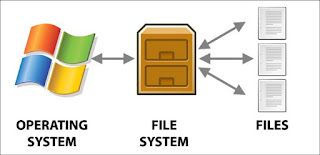FAT:
FAT (File Allocation Table) is one of the simplest types of a file system. It consists of a file system descriptor sector (boot sector or superblock), a file system block allocation table (referred as File Allocation Table) and plain storage space to store files and folders. Files on FAT are stored in directories. Each directory is an array of 32-byte records, each defining file or file extended attributes (e.g. long file name). File record attributes the first block of a file. Any next block can be found through a block allocation table by using it as linked-list.
FAT (File Allocation Table) is one of the simplest types of a file system. It consists of a file system descriptor sector (boot sector or superblock), a file system block allocation table (referred as File Allocation Table) and plain storage space to store files and folders. Files on FAT are stored in directories. Each directory is an array of 32-byte records, each defining file or file extended attributes (e.g. long file name). File record attributes the first block of a file. Any next block can be found through a block allocation table by using it as linked-list.
Block allocation table
contains an array of block descriptors. Zero value indicates
that the block is not used and non-zero – relates to the next
block of the file or a special value for file end.
The numbers in FAT12, FAT16, and FAT32 stands for the number if bits used to enumerate file system block. This means that FAT12 can use up to 4096 different block references, whileFAT16 and FAT32 can use up to 65536 and 4294967296 accordingly. Actual maximum count of blocks is even less and depends on implementation of a file system driver.
FAT12 was used for old floppy disks. FAT16 (or simply FAT) and FAT32 are widely used for flash memory cards and USB flash sticks. The system is supported by mobile phones, digital cameras and other portable devices.
FAT or FAT32 is a file system, used on Windows-compatible external storages or disk partitions with size under 2GB (for FAT) or 32GB (for FAT32). Windows cannot create FAT32 file system over 32GB (however Linux supports FAT32 up to 2TB).

Perfect
ReplyDelete